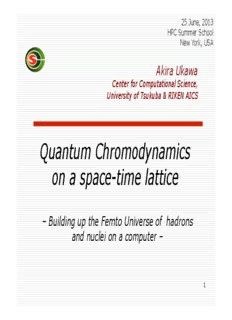
Quantum Chromodynamics on a space-time lattice - Prace Training PDF
Preview Quantum Chromodynamics on a space-time lattice - Prace Training
25 June, 2013 HPC Summer School New York, USA(cid:1) Akira Ukawa Center for Computational Science, University of Tsukuba & RIKEN AICS(cid:1) Quantum Chromodynamics on a space-time lattice – Building up the Femto Universe of(cid:7)hadrons and nuclei on a computer – 1 Four decades of Lattice QCD 1975 1980 1985 1990 1995 2000 2005 2010 2020 1973 QCD 1974 lattice QCD Physics 1st spec calculation 1981 Hamber-Parisi Weingarten 0.8fm 1.6fm 3.0fm 2.4fm Lattice size L 43x8 163x32 643x118 243x48 Nf=0 quenched 6.0fm Algorithms 643x128 Nf=2 u,d Nf =#sea Nf=2+1 u,d,s quarks 4th generation 5th generation 3rd generation 10Pfops 2nd generation 10Tfops Machines 10Gflops 1Tfops 1st generation K comouter APE100 1Gflops APE1 QCDPAX QCDOC BlueGene/Q QCDSP CP-PACS PACS-CS Today’s agenda " Lattice QCD as science " Lattice QCD as computation " A few epoch-making calculations " (Other) challenges of Lattice QCD " Conclusions and perspectives 3 Lattice QCD as science 4 The Standard Model (cid:12)(cid:3)building blocks at the age 10-6 sec(cid:12) ! Matter particles u s t & # & # & # $ ! $ ! $ ! " 6 quarks d c b % " % " % " & e # &µ# &τ# " 6 leptons $ ! $ ! $ ! $ ! $ ! $ ! ν ν ν % e" % µ" % τ" ! Particles mediating interactions γ " photon Electromagnetism Weinberg-Salam " Weak bosons W, Z Weak interactions theory (1967) " gluons g Strong interaction Quantum Chromodynamics ! Particle which breaks EW symmetry (QCD) (1973) (and gives rise to masses of particles) " Higgs boson H Englert-Brout, Higgs, … (1964) ( ) ( ) ( ) SU 3 ⊗ SU 2 ⊗U 1 ! Gauge field theory based on QCD EM +Weak Has to add Lee-Yang(cid:1) Standard Model and Nobel Prize in Physics(cid:1) 1965 Tomonaga(cid:8)Schwinger(cid:8)Feynman Renormalization theory(cid:1) 1949 QED Spontaneous breakdown 2008 Nambu of symmetry(cid:1) 1967 EW theory 1979 Glashow(cid:8)Salam(cid:8)Weinberg 1982 Wilson Renormalization group (cid:1) 2008 Kobayashi(cid:8)Maskawa 6 quarks and CP violation(cid:1) 1973 QCD 1999 tHooft(cid:8)Veltman Renormalization of non-Abelian gauge theories(cid:1) 2004 Gross(cid:8)Politzer(cid:8)Wilczek Asymptotic freedom (cid:1) 6 Quarks, hadrons, nuclei and Quantum Chromodynamics (QCD)(cid:1) −15 The Femto Universe(cid:1) 1 fm = 1×10 m Nuclei(cid:1) H, He,…, C,…, O,…, Fe,…, U,…(cid:1) hadrons quarks(cid:1) e.g., proton and neutron(cid:1) u d u u ≈ 2 fm 1/3 ≈ 1.6A fm Natural elements (nuclei) are governed by Quantum Chromodynamics (QCD) Cf. Chemistry is governed by quantum electrodynamics (QED) 7 A few more words on quarks and hadrons(cid:1) ! 6 types of quark “flavors” 2 u c t Q = + e Carry fractional charge in up charm top 3 s 1 units of electron charge(cid:1) d b Q = − e down strange bottom 3 Heavier mass(cid:1) ! various flavor combinations produce a few hundred particles called “hadrons” u u s proton(cid:1) d neutron(cid:1) d Ω baryon(cid:1) s (cid:8)(cid:8)(cid:8)(cid:8)(cid:8)(cid:1) u d s See Particle Data Group http://pdg.lbl.gov/ for a full list(cid:1) ! Yet, no isolated quarks have been found in experiments; quarks are confined under normal circumstances 8 Quantum Chromodynamics Gross-Wilczek-Politzer 1973 ! Quantum field theory of quarks and gluons q (x) quark field f defined at every 4-dim space-time point A (x) gluon field x = (x , x , x ,t) µ 1 2 3 ! Quarks carry color(chromo) charge, and gluons mediate the interaction between color charges Cf. electrons carry electric charge, and photons mediate the interaction between electric charges ! Given the coupling strength and 6 quark masses, allows first- principles calculations of all the properties of hadrons and nuclei e2 α = color QCD coupling strength s 4πc m , m , m , m , m , m 6 quark masses u d s c b t (cid:4)fulfilling Yukawa(cid:3)s dream of 1934 in a refined way(cid:5)(cid:1) 9 Three fundamental features of QCD ! Described by quark and gluon fields defined at every point of space-time, and NOT by particles q (x) A (x) x = (x , x , x ,t) quark field gluon field f µ 1 2 3 ! Local interaction only, i.e., no points separated by a finite distance interact, only neighboring points do so 1 L (x) = Tr(F (x)F (x))+∑q (x)(γ ⋅(∂ −iA (x))+ m )q (x) QCD µν µν f µ µ µ f f 8πα s f QCD Lagrangian ! Relativistic quantum mechanical system; the fundamental equation is an integral over fields (Feynman), and NOT a partial differential equation 1 − ∫ d4xL (x) O(A, q, q) = ∫ ∏dA(x)dq (x)dq(x) O(A, q, q)e QCD Z x Physical quantities by Feynman path integral 10
Description: